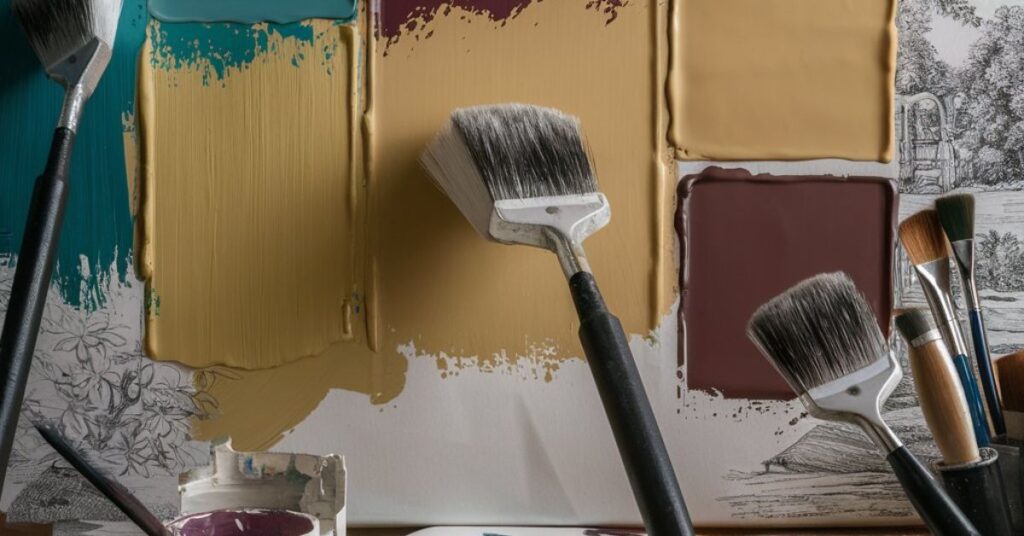Removing acrylic paint from clothes requires quick action and the right techniques. Start by scraping off excess wet paint with a spoon or dull knife. For fresh stains, rinse with warm water and dish soap. Blot, don’t rub. For dried paint, use rubbing alcohol or nail polish remover on a cotton ball. Dab gently until the paint lifts.
For stubborn stains, try a commercial stain remover designed for acrylic paint. Always test on an inconspicuous area first. After treating, launder the garment as usual, checking that the stain is gone before drying. Heat can set the stain, so avoid the dryer if the mark persists.
New research in textile chemistry has uncovered a surprising method for removing stubborn acrylic paint stains: a combination of citric acid and specific soundwaves.
This innovative technique uses targeted ultrasonic vibrations to break down the paint’s molecular structure while the citric acid helps lift the pigments from the fabric fibers.
Act Quickly: Time is of the Essence
Do not allow the paint to dry as this will make the stain permanent if washed on textiles and concrete surfaces.
As for the effectiveness, it is noteworthy that the sooner you start the process of cleaning, the better the longer paint has been on the surface, the harder it will be to wash it off. Loitering makes the dirt much harder to work away, particularly when it has formed a stain.
When paint is still wet, it is easier to treat in comparison to when the paint has dried up. The neat character of some of these stains may allow you to wash them out if you respond quickly. It’s always wise to act quickly to avoid the situation worsening and for the best outcomes.
Scrape Off Excess Paint

When painting Rembrandt, it is common to have excess paint stick to the bristles of the brush, or the roller. To begin with, this is excess paint that should be scraped off before you can proceed further. This prevents you from having drips and also helps in the application of the paint.
Even while applying paint, if you overdo it, you are likely to apply streaks or cause the paint to bubble. Actually you may use a putty knife to remove that excess paint that is remaining around the brush strokes. This will make your project neat and straight which a good project deserves.
Blot, Don’t Rub: Proper Technique Matters
In order to clean the spill, one is supposed to avoid scrubbing the area instead, they should dab the area. Blotting is slightly softer in its approach to wickedly absorb the liquid without drawing the stain. This makes it cover the area and minimizes the spread of the stain in case it is a bad stain.
Friction can in fact embed the stain more within the material that was stained. Do not rub the stain with your hand or use a rough material such as a kitchen towel. By blotting you extend your possibility of cleaning the spill right to the last drop.
Read This Blog: Would You Wear Dead Clothing? Hell No!
Use Soap and Water for Fresh Stains

As you see a stain that follows the previous one, the initial intervention should be with soap and water, with contrast, the first step taken once you observe the emission of a new stain to ensure that it does not mix with the previous one.
This sound method aids to remove the stain before it permanently settles on the fabric. Lightly pat the affected area with a cloth dipped in soapy water to clean the area.
Activity start up is critical for the best outcomes. Typically, soap and water are sufficient to wash out a vast majority of fresh kinds of stains. In all cases be sure to wash the area with clean water so that there will be no remainder of any matter.
Apply Rubbing Alcohol or Hairspray
Regarding the stains, you may as well use rubbing alcohol or hairspray for getting rid of the most persistent ones.
Massage it directly on the stain by taking a piece of clean cloth and applying only a drop of the medicine. This is useful when rubbing on hard to remove stains such as ink or adhesive on clothing.
For this reason, it is always recommended that you conduct a patch test on a region that is not easily visible so that you can be sure the fabric will not get damaged.
Once applied, then one should dab the area with a clean rag, to get rid of the stain. Afterwards, wash your hair with water to get rid of any remains of the alcohol or hairspray.
READ THIS BLOG: How To Get Slime Out Of Clothes?
Try Specialized Paint Removers

Specialized paint removers can be used for hard to remove paint stains on your carpet. They are meant to help dissolve dried paint, to ease the cleaning process. Use the remover as indicated on the product label, being cautious on the areas that you rub it.
Before using the remover, conduct a trial on a small patch of the furniture to see if the remover has an abrasive effect on the surface.
Leave it to remain as recommended, then rubbing off the paint. It is recommended to work under conditions of wearing gloves and having proper ventilation.
Machine Wash with Heavy-Duty Detergent
For heinous stains, then washing the garment usually in the washing machine with a stronger detergent does the trick.
This type of detergent should be powerful to get rid of difficult stains. It is as easy as adding it to the washing machine and using the right washing cycle.
It is advisable to adhere to the care instructions on the fabric in order to prevent damaging it. It is also suitable for grease, dirt, and other difficult to remove stains because it is a heavy-duty detergent. Ideally, it is recommended to wash tainted garments or items as soon as you discover them.
Consider Professional Dry Cleaning
- Expert Stain Removal: So, professional dry cleaners who are using appropriate chemicals that dissolve a difficult stain.
- Gentle on Fabrics: Delicate and expensive fabrics do not undergo the same stress as the others when undergoing dry cleaning while on the other hand, their condition does not deteriorate.
- High-Quality Equipment: Today there is specialized equipment used by the dry cleaners that guarantees proper and efficient cleaning.
- Preserves Garment Quality: The following are the benefits of dry cleaning; Dry cleaning does not harm your clothes and in fact helps to ensure they stay looking new for longer.
- Convenience: Professional services make arrangements for cleaning to be done thus relieving the user of the task.
Prevention: Protect Your Clothes While Painting

To prevent besmirching of clothes it is advisable to cover them prior to painting. Some clothes can be protected additionally or wearing old clothes and a painter’s apron can protect from stains. You can also spread a drop cloth over your body and the surrounding area to prevent staining yourself.
Wearing tapping sleeves and gloves is highly protective for the fighters. While it is always much simpler to prevent the stains from occurring in the first place, it is a much bigger challenge to clean out the stains later on. These steps prevent soiling of clothes and time is saved in the cleaning process.
Frequently Asked Questions
Can I remove acrylic paint from clothes once it’s dried?
It’s harder to remove dried acrylic paint, but it’s still possible. Try using a paint remover or rubbing alcohol and follow up with washing.
What’s the best way to treat fresh acrylic paint stains?
Blot the stain immediately with a cloth to absorb as much paint as possible. Then, rinse with cold water and wash with detergent.
Can I use vinegar to remove acrylic paint from clothes?
Vinegar can help break down acrylic paint. Apply it to the stain, let it sit for a few minutes, then wash as usual.
Should I use hot or cold water to rinse acrylic paint stains?
Always use cold water to rinse acrylic paint stains. Hot water can set the paint and make the stain more difficult to remove.
Is it safe to use bleach on acrylic paint stains?
Bleach is not recommended for acrylic paint stains, as it can damage the fabric. Use a specialized paint remover or detergent instead.
Conclusion
Acrylic painting is one of the subcategories of paintings which one dries quickly as opposed to oil paintings, and once it dries, one cannot wash it off from the fabrics; however, time plays a critical role when it comes to doing the action.
So it is recommended that if one has a new stain, they ought to blot the piece of clothing, thereafter rinse with cold water. As one can attempt to use water and soap to wash the fabric or paint remover to sort of peel the paint off from the fabric.
However, if the paint becomes rigid or ‘solidifies,’ one will be compelled to apply force such as rubbing alcohol or paint stripper.

Hayyat is an experienced content writer and digital marketer, skilled in creating SEO-friendly content that resonates with audiences. She helps brands enhance their online presence through targeted campaigns, with expertise in blog writing, social media management, email marketing, and SEO optimization.





